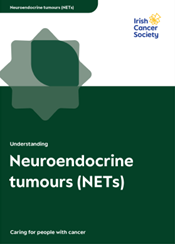Peptide receptor radionuclide therapy (PRRT)
PRRT is a type of internal radiotherapy. PRRT may be used for NETs that have spread. PRRT will only be considered if you have receptors on your cancer cells that allow them to be targeted by the radiation.
A radioactive substance is put into your bloodstream through a drip. Most patients have 4 treatments (infusions), about 8 weeks apart. The time between treatments may be longer, depending on how you are responding to treatment and availability of treatment. You will usually stay overnight in hospital for the first infusion. For the remaining 3 infusions you may stay in hospital overnight or go home the same day.
You will be checked at the PRRT clinic in between treatments. You will have a scan to check the amount of radioactivity delivered to certain organs. Your bloods will also be checked regularly, to make sure you are well enough to have the next infusion.







